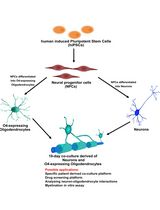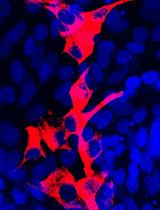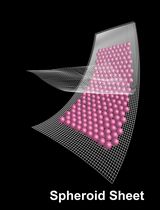- EN - English
- CN - 中文
In vitro Self-organized Mouse Small Intestinal Epithelial Monolayer Protocol
小鼠小肠上皮单层膜体外自组装实验方案
(*contributed equally to this work) 发布: 2020年02月05日第10卷第3期 DOI: 10.21769/BioProtoc.3514 浏览次数: 10705
评审: Tomohiro MizutaniAnonymous reviewer(s)

相关实验方案

人 iPSC 衍生神经元与少突胶质细胞共培养用于髓鞘形成的小分子筛选分析
Stefanie Elke Chie [...] Maria Consolata Miletta
2025年05月05日 3266 阅读
Abstract
Developing protocols to obtain intestinal epithelial monolayers that recapitulate in vivo physiology to overcome the limitations of the organoids’ closed geometry has become of great interest during the last few years. Most of the developed culture models showed physiological-relevant cell composition but did not prove self-renewing capacities. Here, we show a simple method to obtain mouse small intestine-derived epithelial monolayers organized into proliferative crypt-like domains, containing stem cells, and differentiated villus-like regions, closely resembling the in vivo cell composition and distribution. In addition, we adapted our model to a tissue culture format compatible with functional studies and prove close to physiological barrier properties of our in vitro epithelial monolayers. Thus, we have set-up a protocol to generate physiologically relevant intestinal epithelial monolayers to be employed in assays where independent access to both luminal and basolateral compartments is needed, such as drug absorption, intracellular trafficking and microbiome-epithelium interaction assays.
Keywords: Mouse intestinal organoids (小鼠肠道类器官)Background
The development of epithelial organoid culture systems is a major scientific achievement that has been established as an important tool in many basic biology and clinical applications due to their similarity in cell composition and function to the in vivo organ. Specifically, intestinal epithelial organoids are spherical formations with budding structures containing stem, Paneth and proliferative cells, corresponding to intestinal crypts, and inter-budding areas of differentiated cells representing the intestinal villi (Sato et al., 2009; Ootani et al., 2009). One of the major drawbacks of the intestinal organoid system is their closed-spherical structure which hampers their use in standard functional assays in which direct access to the organoid lumen or apical site of the epithelium is required. In the last few years, several attempts to open-up the spherical organoids into 2D monolayers have been established (Moon et al., 2014; VanDussen et al., 2015; Ettayebi et al., 2016; In et al., 2016; Kozuka et al., 2017). However, the reported epithelial monolayers were mainly composed of mature epithelial cells with poor characterization of the proliferation and self-renewing capacities. More recently, methods to obtain monolayers with both proliferative and differentiated regions have been published. Although showing a physiologically relevant cell composition and distribution, those monolayers did not expand enough to cover the full substrate area and did not allow access to the basolateral site preventing their use in functional assays (Wang et al., 2017a; Liu et al., 2018; Thorne et al., 2018).
Here, we describe an experimental protocol in which we grow either Lgr5-EGFP-ires-Cre ERT2 mouse organoid-derived crypts or single cells on a thin layer of Matrigel to obtain intestinal epithelial monolayers that self-organize in crypt foci, containing stem cells, Paneth and proliferative cells, and villi-like regions composed of differentiated cells, resembling the cell distribution found in the in vivo small intestine. Importantly, our results indicate that the capacity of the intestinal epithelial cells to first self-organize into crypt-like domains and then originate villus-like regions is regulated intrinsically and is not due to the preservation of pre-established crypt configuration. We successfully adapted this method to a Transwell inserts culture format, as previously described (Wang et al., 2017b), which allow an independent access to the basolateral and apical compartments, and demonstrate that the basolateral administration of crypt medium supplemented with non-epithelial niche-derived biochemical factors boosted epithelial monolayer expansion to fully cover the tissue culture substrate without altering the crypt-villus-like cell distribution.
These features of our model enable to perform functional assays such as to record transepithelial electrical resistance (TEER) measurements to determine the monolayers’ epithelial barrier properties. We found that TEER values were within the expected physiological range (40-100 Ω cm2) for mouse small intestine, demonstrating an adequate maturation of de novo generated epithelium. Overall, we have developed a protocol to generate organoid-derived intestinal epithelial monolayers with in vivo-like structural and functional features in a culture format compatible with functional assays. We believe our technology meet the necessary features of the complex 3D organotypic cell culture systems and 2D formats for a close to physiological high-throughput testing.
Materials and Reagents
- Materials
- Petri dishes, 94 x 16 mm, sterile (Biolab, catalog number: 020005)
- Glass coverslips 24 x 24 mm (Deltalab, catalog number: D102424)
- Serological pipettes 5 ml, 10 ml, 25 ml (Nunc, catalog numbers: 056815, 056816, 056817)
- Racked filter pipette tips 20 µl, 200 µl, 1,000 µl, sterile (Labclinics, catalog numbers: LAB20ULFNL, LAB200ULFNL, LAB1000ULFNL)
- 70 µm pore cell strainer (Biologix Research Co., catalog number: 151070)
- 24-well multiwell plates (Nunc, catalog number: 142485)
- Falcon, 50 ml centrifuge tubes (Deltalab, Eurotubo, catalog number: DEL429927)
- Falcon, 15 ml centrifuge tubes (Deltalab, Eurotubo, catalog number: DEL429946)
- Ibidi 8-well µ-Slides (Ibidi GmbH, catalog number: 80826)
- Transwell polycarbonate membrane cell culture inserts, 6.5 mm diameter, 0.4 µm pore size (Corning, catalog number: CLS3413)
- 23 G 1" needle (BD Microlance 3, catalog number: 300800)
- Disposable 1 ml syringe (B-Braun, catalog number: 9166017V)
- Disposable 10 ml syringe (Becton Dickonson, catalog number: 309110)
- Cell culture flasks, filter cap 25 cm2 (Nunc EasYFlasks, catalog number: 156367)
- Syringe filter, 0.22 µm pore size, sterile (Millipore, Millex, catalog number: SLGP033RS)
- Reagents
- Phosphate buffered saline (PBS) powder, pH 7.4 (Sigma-Aldrich, catalog number: P3813), store at RT
- Ethylenediaminetetraacetic acid (EDTA) solution, pH 8.0, ~0.5 M (Sigma-Aldrich, catalog number: 03690), store at RT
- Matrigel Basement membrane matrix, LDEV-free (Corning, catalog number: 354234), store at -20 °C
Note: Thaw O/N on ice and aliquot in 0.5-1 ml vials upon arrival, to minimize freeze and thaw cycles. - Advance Dulbecco’s modified medium (DMEM)/F12 (Thermo Fisher Scientific, Gibco, catalog number: 12634010), store at 2-8 °C
- GlutaMAX supplement, 100x (Thermo Fisher Scientific, Gibco, catalog number: 35050038), store at 2-8 °C
- 4-(2-hydroxyethyl)-1-piperazineethanesulfonic acid (HEPES) buffer solution, 1 M (Thermo Fisher Scientific, Gibco, catalog number: 15630056), store at 2-8 °C
- Normocin (InvivoGen, catalog number: ant-nr-2), store at -20 °C
- B-27 supplement, minus vitamin A, 50x (Thermo Fisher Scientific, Gibco, catalog number: 12587010), store at -20 °C aliquoted
- N-2 supplement, 100x (Thermo Fisher Scientific, Gibco, catalog number: 17502048), store at -20 °C aliquoted
- N-Acetyl-L-cysteine (Sigma-Aldrich, catalog number: A9165), store at -20 °C aliquoted
- Recombinant murine Epidermal growth factor (EGF) (Thermo Fisher Scientific, Gibco, catalog number: PMG8043), store at -20 °C aliquoted
- Recombinant human R-spondin 1 (R&D Systems, catalog number: 4645-RS-250), store at -20 °C aliquoted
- Recombinant murine Noggin (Peprotech, catalog number: 250-38), store at -20 °C aliquoted
- Y-27632 Dichloride, powder (Sigma-Aldrich, catalog number: Y0503, reconstitute at 1 mM in sterile Milli-Q and store at -20 °C aliquoted)
- CHIR99021 (Stemgent, catalog number: 04-0004), store at -20 °C aliquoted
- Valproic acid sodium salt (Sigma-Aldrich, catalog number: P4543, reconstitute at 1 M in sterile Milli-Q and store at -20 aliquoted)
- TrypLE Express enzyme, with phenol red, 1x (Thermo Fisher Scientific, Gibco, catalog number: 12605010), store at 2-8 °C
- Fetal bovine serum (FBS), heat inactivated (Thermo Fisher Scientific, Gibco, catalog number: 10500064), store at -20 °C
- DMEM, high glucose, GlutaMAX supplement, pyruvate (Thermo Fisher Scientific, Gibco, catalog number: 31966021), store at 2-8 °C
- Penicillin-streptomycin, with 10,000 units penicillin and 10 mg streptomycin per ml in 0.9% NaCl (Sigma-Aldrich, catalog number: P0781), store at -20 °C
- Minimum essential medium non-essential amino acid (MEM-NEA) solution, 100x (Thermo Fisher Scientific, Gibco, catalog number: 11140035), store at 2-8 °C
- Collagenase (Sigma-Aldrich, catalog number: C0130), store at -20 °C
- ACK Lysing Buffer (Gibco, catalog number: A10492-01), store at RT
- Ethanol, 96% v/v (PanReac Applichem, catalog number: 131085), store at RT
- Intestinal organoid growth medium or ENR_CV medium (see Recipes section, Table 1)
- Intestinal subepithelial myofibroblast digestion medium (see Recipes section, Table 2)
- Intestinal subepithelial myofibroblast culture medium (see Recipes section, Table 3)
- Boosting medium (see Recipes section, Table 4)
- Basic-medium (see Recipes section, Table 5)
- 70% v/v Ethanol (see Recipes section, Table 6)
Equipment
- Surgical tweezers (Biolab, catalog numbers: 711198 and 711199)
- Surgical scalpel (Paramount, catalog number: PCS23)
- Surgical scissors (Biolab, catalog number: 005064)
- 37 °C water bath (Fisher Scientific, Polytest 20)
- Milli-Q water purification system (Millipore, Q-POD)
- Neubauer counting chamber (BRAND, catalog number: 718605)
- Micropipettes (Gilson, models: P20, P200, P1000)
- Pipette aid (Eppendorf, Easypet)
- Cell culture benchtop centrifuge (Beckman Coulter, model: Allegra X-12R)
- 37 °C humidified incubator with 5% CO2 (Thermo Scientific, Steri-Cult 3141)
- Laminar flow hood (Telstar, BIO II A)
- Platform Shaker (Heidolph, model: Unimax 1010)
- Incubated benchtop orbital shaker (Thermo Scientific, 4518 S/N 15150-131)
- Bright field microscope (Nikon, Eclipse Ts2)
- Epithelial voltohmmeter with STX3 electrodes (World Precision Instruments, EVOM2)
- Ice machine (Scotsman, MF56)
Procedure
文章信息
版权信息
© 2020 The Authors; exclusive licensee Bio-protocol LLC.
如何引用
Altay, G., Batlle, E., Fernández-Majada, V. and Martínez, E. (2020). In vitro Self-organized Mouse Small Intestinal Epithelial Monolayer Protocol. Bio-protocol 10(3): e3514. DOI: 10.21769/BioProtoc.3514.
分类
干细胞 > 多能干细胞 > 细胞分化
细胞生物学 > 细胞分离和培养 > 细胞分化
细胞生物学 > 细胞工程 > 组织工程
您对这篇实验方法有问题吗?
在此处发布您的问题,我们将邀请本文作者来回答。同时,我们会将您的问题发布到Bio-protocol Exchange,以便寻求社区成员的帮助。
Share
Bluesky
X
Copy link












